Ever grabbed a towel after a shower only to find it rough and barely absorbent? Quality matters more than you think—it affects comfort, durability, and even hygiene. Towels have evolved from ancient linen cloths to today’s plush, high-tech designs.
The best towels balance absorbency1, softness, and durability through premium materials like long-staple cotton2, tight weaving techniques, and proper finishing processes. Key factors include fiber type, GSM (grams per square meter)3, and loop density.

From the cotton fields to your bathroom, every step in a towel’s journey impacts its performance. Let’s unravel the science behind what makes some towels luxuriously soft while others fall flat.
What Raw Materials Make a Great Towel?
Why do some towels feel like sandpaper while others mimic clouds? The secret starts with the fibers. Not all materials are created equal—your towel’s DNA determines its lifespan and performance.
Premium towels use long-staple cotton (Egyptian, Pima, or Turkish4) for superior softness and absorbency. Alternatives like bamboo5 (naturally antibacterial) and microfiber (quick-drying) suit specific needs, but cotton remains the gold standard for plushness.
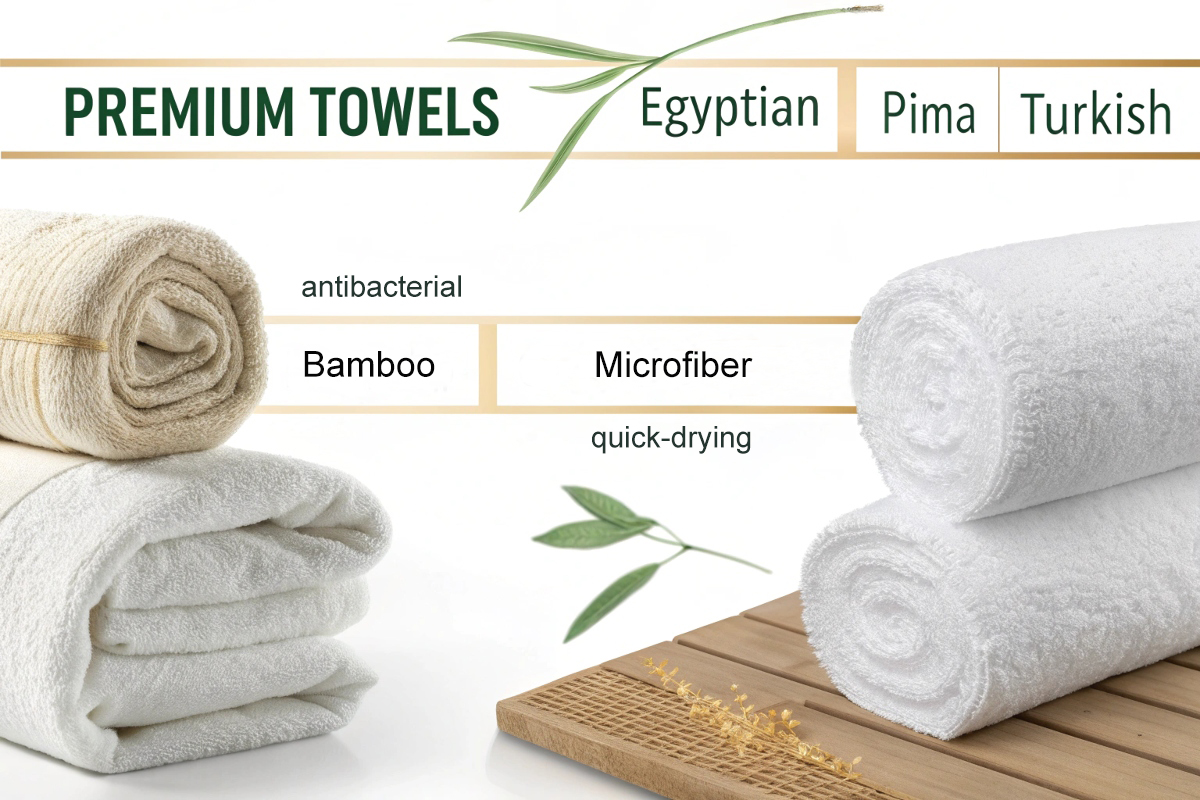
Fiber Breakdown: From Fields to Yarn
Here’s how top materials compare:
| Material | Pros | Cons | Best For |
|---|---|---|---|
| Egyptian Cotton | Long fibers, high absorbency | Expensive | Luxury bath towels |
| Pima Cotton | Soft, durable | Less fluffy than Egyptian | Everyday use |
| Turkish Cotton | Balanced cost/performance | Varies by brand | Spa-style towels |
| Bamboo | Eco-friendly, antimicrobial | Less durable | Gym/beach towels |
| Microfiber | Lightweight, quick-drying | Can trap odors | Travel/sports |
Long-staple fibers (over 1.5 inches) create smoother yarns with fewer exposed ends—that’s why Egyptian cotton feels silkier. The yarn’s twist matters too: tighter twists boost durability but reduce initial softness. For beach towels, synthetic blends add fade resistance, while organic cotton suits sensitive skin.
Why Yarn Thickness & Loop Density Matter
A thick, plush towel usually has a high loop density6. This means more surface area to absorb moisture. But thicker isn’t always better. If the loops are too tight or the yarn twist is too high, water won’t absorb well. Ideally, towels should have long fibers and a low-to-medium twist for both softness and function.
How Are Towels Manufactured Step-by-Step?
Ever wondered why two “100% cotton7” towels perform so differently? Manufacturing techniques turn raw fibers into terry cloth masterpieces—or disappointments. The devil’s in the details, from dyeing methods to loop construction.
Quality towels undergo yarn preparation (dyeing, waxing), weaving (loop terry8 for absorbency or cut-pile for softness), and finishing (washing, brushing). Superior brands test for colorfastness, pilling resistance, and absorbency rates exceeding 400 GSM.
The Production Process Decoded
-
Yarn Prep:
- Pre-dyed yarns (solution dyeing) resist fading but limit color options.
- Post-dyed yarns offer vibrant hues but may bleed initially.
-
Weaving the Fabric:
- Loop Terry: Uncut loops maximize water absorption (common in bath towels).
- Cut-Pile: Sheared loops create velvety surfaces (found in plush robes).
- Handloom vs. machine: Machine-woven towels dominate commercial production for speed and consistency.
-
Finishing Touches:
- Washing/Bleaching: Removes residues. White towels often go through intense bleaching.
- Softening agents: Used to create that plush, soft hand-feel.
- Inspection: Absorbency tests, shrinkage resistance, and pilling checks are done before shipment.
Industrial looms weave 200+ towels hourly, while handloom techniques (like those in Turkey’s Denizli region) produce artisanal pieces. A single flaw in the warp/weft alignment can cause uneven pile or premature wear.
How Do Towels Achieve Ultimate Softness & Absorbency?
Why do new towels sometimes repel water? Real softness isn’t about chemicals—it’s about physics. The interplay between fiber structure and finishing determines whether your towel pampers or scratches.
Long-staple cotton fibers with moderate twist and loop density (90-150 loops/sq inch) deliver ideal softness and absorbency. Mechanical brushing raises fibers naturally, while chemical softeners coat fibers—reducing water absorption by up to 20%.
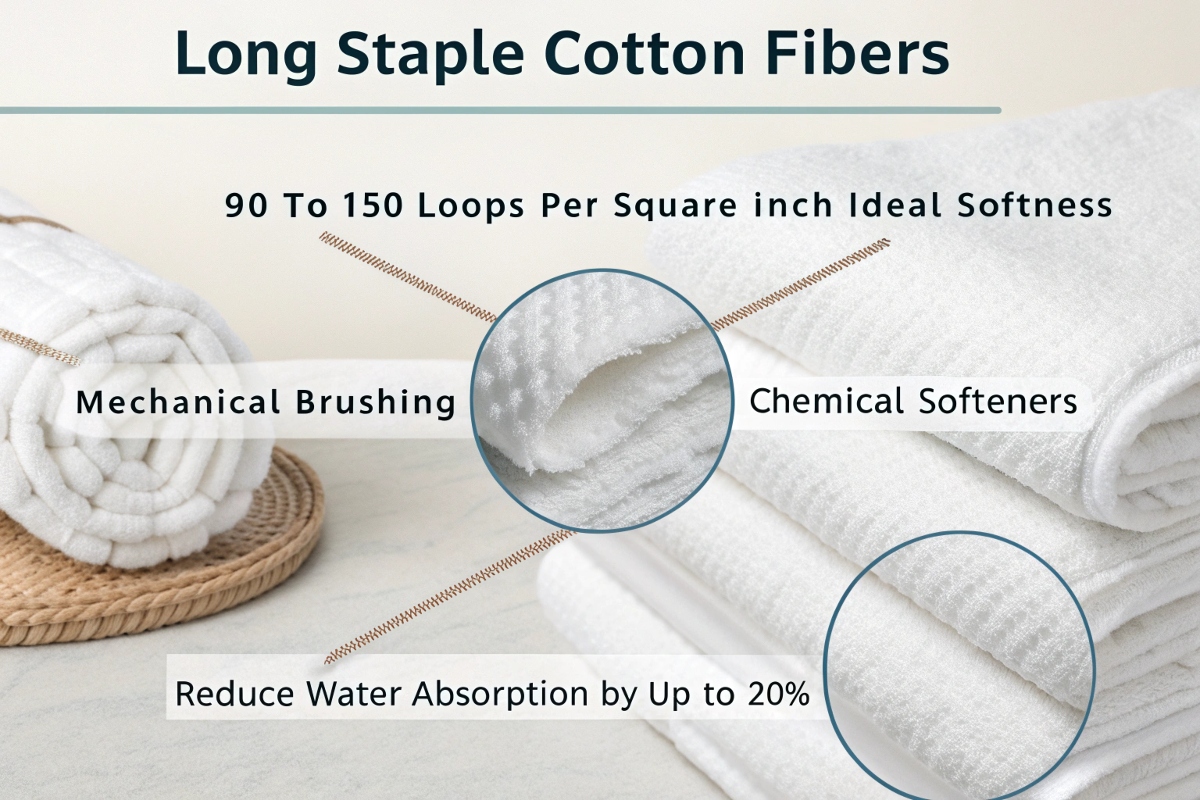
Key Factors Affecting Texture
| Factor | Softness Impact | Absorbency Impact |
|---|---|---|
| Fiber Length9 | Long fibers = less fraying, more softness | Long fibers hold more water |
| Yarn Twist10 | Low twist = softer feel | Too low twist = less durable |
| Brushing/Sanding | Fluffs surface fibers for plush texture | May reduce long-term durability |
| Chemical Softeners11 | Immediate softness, artificial feel | Can clog loops, reduce absorbency |
Brushing is a mechanical process that raises the loops on the towel’s surface, making them feel fluffier. Chemical softeners coat the fibers, but repeated washing removes this effect. Long-term softness usually comes from high-quality raw materials and smart spinning—not chemicals.
The Science Behind the Squeeze
-
Fiber Length: Longer fibers = fewer exposed ends = smoother surface.
-
GSM Guide:
- 300-400 GSM: Lightweight (quick-drying, gym bags)
- 500-600 GSM: Plush (everyday bath use)
- 700+ GSM: Luxury (spa-grade, slower to dry)
-
Absorbency Hack:
Wash new towels with ½ cup white vinegar to remove manufacturing residues. Avoid fabric softeners—they leave wax coatings. For fluffiness, tumble dry with wool dryer balls instead.
High-end brands like Frette and Christy use combed cotton (removing short fibers) for consistent pile. Sanding techniques gently abrade surfaces for broken-in softness immediately.
Are Sustainable Towels Possible Without Sacrificing Quality?
Can you pamper yourself and the planet? The towel industry wastes 20,000 liters of water per ton of fabric—but innovations are changing the game. Eco-friendly no longer means scratchy and thin.
Leading sustainable options include GOTS-certified organic cotton12 (no pesticides), recycled cotton13 (from textile waste), and bamboo (needs less water). Brands like Boll & Branch and Coyuchi combine eco-materials with high GSM for guilt-free luxury.
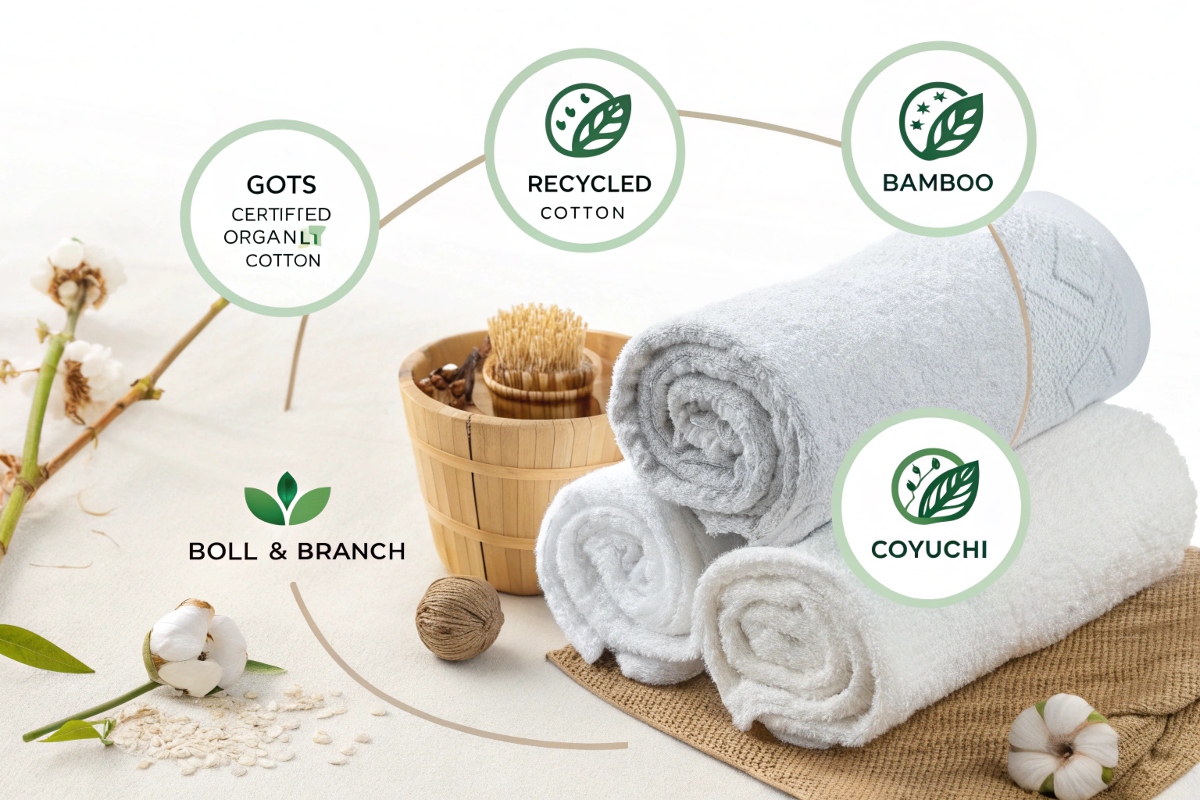
Green Towel Checklist
- Certifications: Look for OEKO-TEX14 (chemical safety), GOTS (organic), or Fair Trade.
- Water Savings: Organic cotton uses 91% less groundwater than conventional.
- Recycled Content: Post-consumer materials reduce landfill waste.
Case Study: Turkey’s Loom for Good initiative transforms 1.2 million plastic bottles annually into polyester towel blends. Meanwhile, hemp towels (though rare) offer mold resistance—perfect for humid climates.
Key Eco-Factors
| Practice | Impact on Environment |
|---|---|
| Organic Cotton15 | Reduces pesticide use |
| Recycled Cotton/Poly Blends | Lowers virgin resource demand |
| Waterless Dyeing Technologies16 | Saves 70-90% water |
| Renewable Energy in Production | Cuts CO₂ emissions |
| Certifications (OEKO-TEX, GOTS) | Verifies chemical safety, ethics |
Companies like Coyuchi, Boll & Branch, and Ecoloom are pioneers in sustainable towel production. At my factory, we aim to use viscose from renewable sources and comply with OEKO-TEX and FSC standards to help customers source responsibly.
How to Choose and Maintain Towels Like a Pro?
Why do hotel towels outlast home ones? It’s not magic—it’s smart selection and care. A 600 GSM towel can disintegrate in months if washed wrong, while a 400 GSM one might thrive for years.
Sustainable towels use organic fibers17, recycle waste, and meet global certifications like OEKO-TEX or GOTS18.
Prioritize GSM (weight) and fiber content based on use: 400-600 GSM for daily baths, 700+ for spas. Wash in warm water (not hot), skip fabric softener, and air-dry occasionally to preserve fibers.
A plush towel isn’t always the best. Your choice should depend on how you use it—and how you wash it.
Check GSM, fiber type, and care instructions to choose towels that last longer and stay soft.
GSM (Grams per Square Meter)
| GSM19 Range | Feel | Best For |
|---|---|---|
| 300–400 | Lightweight, quick | Gym, travel, baby towels |
| 400–600 | Medium plush | Everyday bath towels |
| 600–900 | Ultra-plush, heavy | Spa, luxury experiences |
Towel Care Tips
- Wash before first use to remove coating.
- Avoid fabric softeners—they reduce absorbency.
- Tumble dry on low or line dry to avoid fiber damage.
- Wash in warm water with gentle detergent.
Well-maintained towels last longer, feel better, and save you money over time. Many of my clients in Europe now request care labels in multiple languages to help their end users maintain the product properly.
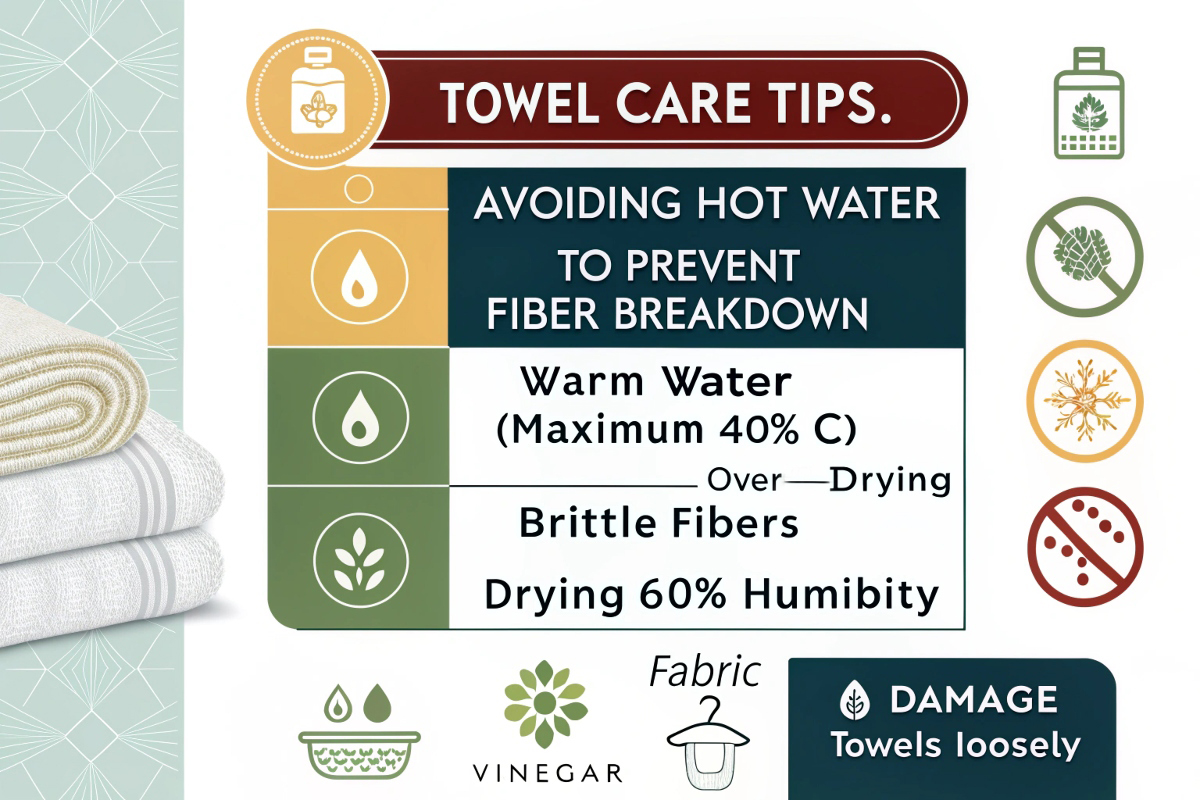
| Mistake | Consequence | Fix |
|---|---|---|
| Hot water | Fiber breakdown | Use warm (40°C max) |
| Over-drying | Brittle fibers | Dry at 60% humidity |
| Softener use | Absorbency loss | Use vinegar rinses |
| Tight folding | Crease damage | Roll or hang loosely |
Pro Tip: Rotate between 3-4 towels to extend lifespan. Store in ventilated spaces to prevent mildew—the #1 killer of towel softness.
What’s Next in Towel Technology?
Could your towel soon fight bacteria or charge your phone? The humble towel is getting a high-tech makeover. From self-cleaning fabrics to embedded sensors, the future is here.
Emerging trends include silver-infused antibacterial towels20, graphene-coated quick-dry versions, and smart towels with moisture sensors21. Japanese brand Imabari even makes temperature-regulating towels22 using phase-change materials.
Expect antibacterial tech, moisture-sensing smart towels, and lighter, faster-drying fabrics in the near future.

Innovations to Watch
- Self-Cleaning: Photocatalytic coatings break down odors under light.
- E-Textiles23: Towels with woven circuits could display hydration levels.
- Biodegradable24: Algae-based fibers that compost in 12 weeks.
- Antibacterial Towels25: Infused with silver or copper ions to kill odor-causing bacteria.
- Quick-Dry Towels: Engineered microfiber and hybrid blends dry in minutes.
- Smart Towels: In development—towels with sensors for health, hydration, or UV monitoring.
While these are still niche, mainstream brands are adopting antimicrobial treatments and tighter eco-standards. The next decade may redefine what we expect from towels entirely.
The next generation of towels will combine wellness, sustainability, and high performance. My R&D team is currently testing seaweed fibers and PLA blends to lead in this transition.
Conclusion
Towel quality starts at the fiber level and ends with how you treat it—choose smart, care wisely, and your towels will reward you.
Elbert Zhao
Founder, Elbert Wipes Solutions
📧 [email protected] | 🌐 www.elbertwipes.com
8 production lines | 22 processing lines | OEKO-TEX certified | Walmart-approved supplier
-
Understanding absorbency can help you choose the best towels for your needs, ensuring comfort and efficiency after every shower. ↩
-
Exploring the advantages of long-staple cotton can guide you in selecting high-quality towels that last longer and feel softer. ↩
-
Learning about GSM will help you understand towel thickness and absorbency, leading to better purchasing decisions. ↩
-
Explore the unique qualities of these cotton types to find the perfect towel that combines luxury and functionality. ↩
-
Discover the benefits of bamboo towels, including their antibacterial properties and eco-friendliness, for a sustainable choice. ↩
-
Learn how loop density impacts the performance of towels, ensuring you choose the best for moisture absorption and comfort. ↩
-
Explore the nuances of cotton towel performance and discover what makes a quality towel stand out. ↩
-
Learn about loop terry construction and its impact on towel absorbency, crucial for choosing the right towel for your needs. ↩
-
Understanding fiber length can help you choose fabrics that offer the best softness and absorbency for your needs. ↩
-
Exploring yarn twist can guide you in selecting durable yet soft fabrics for various applications. ↩
-
Learn about the pros and cons of chemical softeners to make informed choices for fabric care and maintenance. ↩
-
Explore the advantages of GOTS-certified organic cotton towels for a sustainable and luxurious experience without compromising quality. ↩
-
Learn about the process and benefits of recycled cotton, a sustainable choice that helps reduce textile waste while maintaining quality. ↩
-
Understanding OEKO-TEX certification helps you choose safer, eco-friendly textiles, ensuring chemical safety and ethical production. ↩
-
Exploring the benefits of organic cotton reveals its significant environmental advantages, including reduced pesticide use and water savings. ↩
-
Learning about waterless dyeing technologies showcases innovative methods that drastically reduce water usage in the textile industry. ↩
-
Explore the advantages of organic fibers for sustainability and health, making informed choices for your home. ↩
-
Learn about these certifications to ensure your towels are safe and environmentally friendly, enhancing your purchase decisions. ↩
-
Understanding GSM helps you choose the right towel for your needs, ensuring comfort and durability. ↩
-
Explore the advantages of antibacterial towels, including hygiene and longevity, to enhance your towel experience. ↩
-
Learn how moisture sensors can improve towel performance and convenience, making your drying experience smarter. ↩
-
Discover the innovative technology behind temperature-regulating towels for ultimate comfort and usability. ↩
-
Explore the fascinating world of E-Textiles to understand how technology is revolutionizing textiles, including hydration monitoring. ↩
-
Learn about the environmental impact of biodegradable materials and how they contribute to sustainability in the textile industry. ↩
-
Discover the science behind antibacterial towels and how they can enhance hygiene and freshness in your daily life. ↩

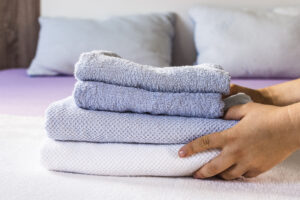
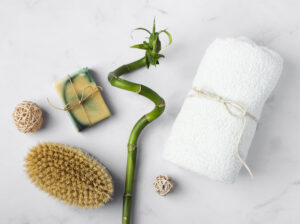
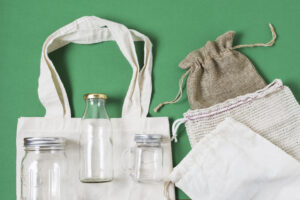

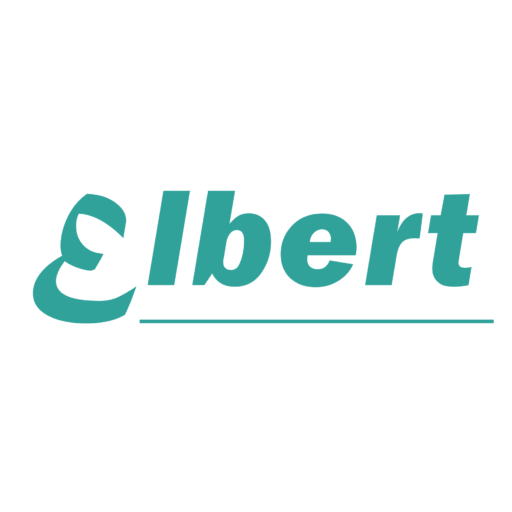
6 Responses
Je recommande vivement Ernestopro.fr pour tous vos besoins en serviettes. Leur expertise dans la fabrication de produits en microfibre garantit des serviettes à la fois douces, absorbantes et durables. Leur sélection de matériaux de haute qualité et leur souci du détail assurent des produits qui répondent parfaitement aux exigences modernes. De plus, leur engagement envers la durabilité et la satisfaction client fait d’Ernestopro.fr un partenaire de confiance pour choisir les meilleures serviettes, aussi bien pour un usage personnel que professionnel. N’hésitez pas à leur faire confiance pour obtenir des produits innovants et résistants, tout en respectant l’environnement.
Thanks!
Thanks
Appreciate you like it!